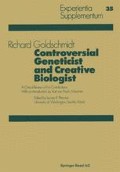Abstract
Richard Goldschmidt was not the founder of a school. While he was at Munich he trained graduate students and some of these, notably Hans Nachtsheim and Julius Seiler, became prominent zoological geneticists. But after Goldschmidt had joined the Kaiser Wilhelm Institut in 1914, he did not teach any more nor did he accept graduate students. He held an appointment as honorary professor at the University of Berlin and his colleague at the Kaiser Wilhelm Institut, Max Hartmann, made use of his appointment giving a successful lecture course and training numerous prominent biologists. Goldschmidt, however, decided on accepting his position that henceforth he would devote himself exclusively to research. Later on, during his tenure at Berkeley he did indeed train a number of graduate students but few of them continued to carry out full-time research in genetics.
Access this chapter
Tax calculation will be finalised at checkout
Purchases are for personal use only
Preview
Unable to display preview. Download preview PDF.
References
H. Spemann, Die Naturwissenschaften 12, 65 (1924).
R.B. Goldschmidt, Cold Spring Harbor Symp. Quant. Biol. 16, 1 (1951).
R.B. Goldschmidt, A. Hannah and L.K. Piternick, Univ. California Publ. Zool. 55, 67 (1951).
R. Goldschmidt, Ascaris, eine Einführung in die Wissenschaft vom Leben für jedermann. Leipzig, T. Thomas (1922).
R. Goldschmidt, Einführung in die Vererbungswissenschaft. 4th edition Leipzig, W. Engelmann (1923).
R. Goldschmidt, Physiologische Theorie der Vererbung. Berlin, Springer (1927).
H.J. Muller, American Naturalist 56, 32 (1922).
R.B. Goldschmidt, Proc. 9th Intern. Cong. Genetics, Caryologia 6 suppl. pt. 1, 83 (1953).
R.B. Goldschmidt, Theoretical Genetics. Berkeley and Los Angeles, Univ. of California Press (1955).
R.B. Goldschmidt. The Material Basis of Evolution. New Haven, Yale Univ. Press (1940).
E. Caspari, in “Female Hierarchies”: edited by L. Tiger. Chicago: Aldine (1977).
Author information
Authors and Affiliations
Editor information
Editors and Affiliations
Rights and permissions
Copyright information
© 1980 Springer Basel AG
About this chapter
Cite this chapter
Caspari, E.W. (1980). An Evaluation of Goldschmidt’s Work after Twenty Years. In: Piternick, L.K. (eds) Controversial Geneticist and Creative Biologist. Experientia Supplementum, vol 35. Birkhäuser, Basel. https://doi.org/10.1007/978-3-0348-5855-7_3
Download citation
DOI: https://doi.org/10.1007/978-3-0348-5855-7_3
Publisher Name: Birkhäuser, Basel
Print ISBN: 978-3-0348-5857-1
Online ISBN: 978-3-0348-5855-7
eBook Packages: Springer Book Archive

